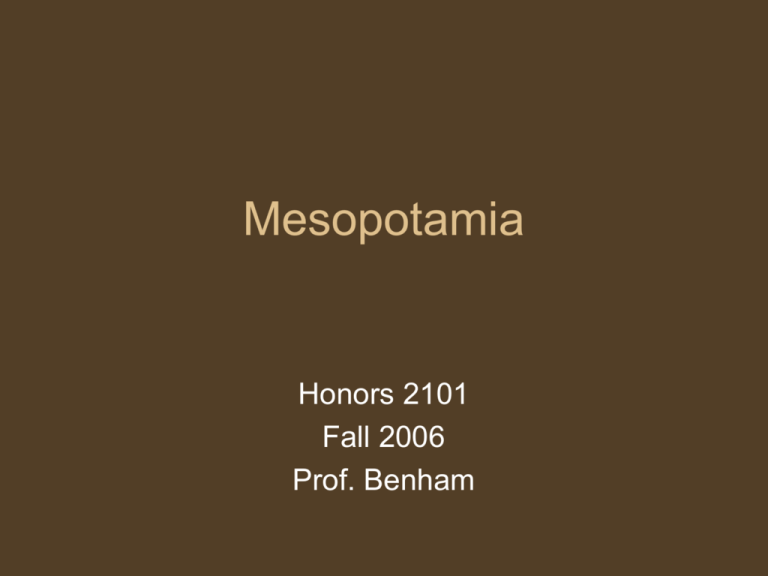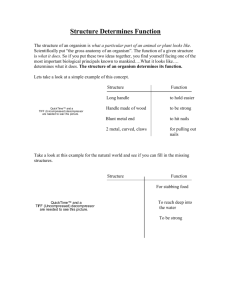Introduction to Mesopotamia
advertisement

Mesopotamia Honors 2101 Fall 2006 Prof. Benham Mesopotamia “between the rivers” • Tigris and Euphrates Region – Modern day Iraq – Region, not a people • But, roughly continuous cultural elements – Polytheism, Fate, Virtue – Sumerian, Akkadian, Babylonian, Assyrian, etc. Map of Ancient Near and Middle East (Fiero, G. (2006). The Humanistic Tradition, Vol 1. 5th ed. McGraw Hill, p.38.) Mesopotamia • Origin – Irrigation, Agriculture, Civilization – Complex urban life (“urban” der. Ur) – Writing (wedged-shaped cuneiform) – Cultural – Mathematics and Astronomy Impact of Mesopotamia • Political/Social Organization • Polytheism (more than 1000 gods) • Motifs and images – (e.g., flood, tower of Babel, righteous sufferer, sacrifice, humans serve gods, etc.) • Cultural Concepts – Underworld – Order/Chaos and Heroism – “Ur-banism” • Harlots and Women Why Mesopotamia? • • • • A “recent” discovery Biblical significance Earliest literature Art, images and motifs • Discovery and Meaning… Mid-19th Century • Archaeologists Austen Henry Layard & Hormuzd Rassam discovered ancient library at Nineveh, buried since 7th century BCE. – ~25,000 clay tablets written in cuneiform • Most were business records, but included two literary works that predate Homer: – Enuma Elish (Epic of Creation) – Epic of Gilgamesh 1872 • George Smith, a translator of the cuneiform tablets announced an account of a flood story that closely resembles the Biblical account. • Since the cuneiform account predates Biblical sources, either: – Biblical writers were familiar/borrowed from it; or – both were drawn from common source. Iraq War, 2003 • Iraq Museum, Baghdad, and Archaeological Sites – Ransacked for artifacts, gold, and precious items – Investigations and Retrieval • (Thieves of Baghdad) QuickTi me™ and a TIFF (Uncompressed) decompressor are needed to see this picture. Read and listen: “Chasing Down History and the ‘Thieves of Baghdad’, at NPR.org http://www.npr.org/templates/story/story.php?storyId=5024219 Recovered • • • • • • The Gold of Nimrud Sacred Vase of Warka The Mask of Warka Golden Harp (Lyre) of Ur Bassetki Statue Clay Pot from Tell Hassuna QuickTime™ and a TIFF (Uncompressed) decompressor are needed to see this picture. QuickTime™ and a TIFF (Uncompressed) decompressor are needed to see this picture. QuickTi me™ and a TIFF (Uncompress ed) decompress or are needed to see this picture. QuickTime™ and a TIFF (U ncompressed) decompressor are needed to see this picture. QuickTime™ and a TIFF (Uncompressed) decompressor are needed to see this picture. • The Gold of Nimrud: a collection of more than 1,000 pieces of gold jewelry and precious stones from 8th and 9th century BCE. Discovered in 1988 and comparableto the discovery of Tutankhamen’s treasure. • Sacred Vase of Warka: world’s oldest known carved stone ritual vessel dating from c. 3200 BCE. • The Mask of Warka: believed to be the world’s oldest known naturalistic sculture of a human face, c. 3100 BCE. • Golden Harp of Ur: a sold gold bull’s head that adorns the harp dated from c. 2600-2500 BCE. It predates the construction of the Pyramids by 750 years. • The Bassetki Statue: one of the earliest known examples of the lost-wax technique, cast in pure bronze, c. 2250 BCE. • Clay Pot from Tell Hassuna: a sixth millennium pot that predates the wheel by at least 1,500 years. Still Missing (12/05) Lioness Attacking a Nubian An extraordinary 8th century BCE ivory plaque inlaid with lapis and carnelian and overlaid with gold. Only two such ivory plaques are known to exit. (The other one is in the British Museum.) QuickTime™ and a TIFF (U ncompressed) decompressor are needed to see this picture. Still Missing (12/05) Ninhursag Bull One of the two twin copper bulls from the face of the temple built by the King of Ur, c. 2475. QuickTime™ and a TIFF (U ncompressed) decompressor are needed to see this picture. Why Mesopotamia? • Important cultural items. • Mesopotamia is in a unique position as one of the origins for human civilization. • Still has significance to us today; still asking and addressing same basic questions about human existence. Timeline Mesopotamia http://www.wsu.edu/~dee/MESO/TIMELINE.HTM Map of Ancient Near and Middle East (Fiero, G. (2006). The Humanistic Tradition, Vol 1. 5th ed. McGraw Hill, p.38.) Timeline Mesopotamia • Sumerian (& Akkadian) Period (~3000-1800) – 2750 1st dynasty of Ur – 2340-2125 Sargon I (The Great) begins Akkadian Empire • Babylonian Period (~1800 - 1170) – 1728-1685 Hammurabi conquers Sumer • Assyrian Period (~1200-612) – 714-681 Reign of Sennacherib (Conquers Judah, 1st exile) – 668-626 Reign of Ashurbanipal (Nineveh) – 612 Fall of Nineveh Timeline Mesopotamia • Neo-Babylonian Period (612-539) – ~650-500 Zarathustra, founder of Persian Zoroastrianism – 605-565 Reign of Nebuchadnezzar (Conquers Judah, Hebrew Exile) – 539 Fall of Babylon to Persians • Persian Period (539-334) – – – – 521-486 Reign of Darius I 490-489 Beginning of “Persian Wars” with Greeks 480-479 Invasion of Greece by Xerxes 479 Defeat of Persians (Xerxes) by Greeks • Alexander the Great conquers Persia (334-331)




